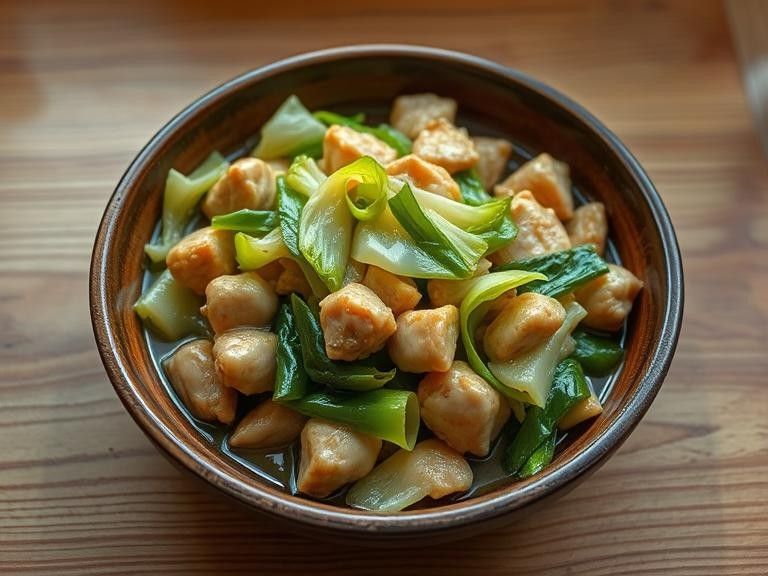Introduction to Hmong Cabbage and Chicken Recipe
Hmong cuisine is a vibrant and deeply cultural experience that reflects the traditions and flavors of Southeast Asia. Among the many cherished dishes, the Hmong cabbage and chicken recipe stands out as a delicious, easy-to-make meal packed with wholesome ingredients. This dish is widely loved for its simplicity, robust flavor, and nutritional value.
If you’re looking for a hearty yet healthy meal, this Hmong cabbage and chicken recipe easy version will become your new go-to dish. With a perfect balance of tender chicken, crisp cabbage, and savory seasonings, this recipe is not only traditional but also adaptable to modern preferences.
The History and Cultural Significance of Hmong Cuisine
Hmong cuisine is deeply rooted in tradition, reflecting influences from neighboring countries, including Chinese cuisine. Hmong people have historically relied on fresh, locally sourced ingredients, making dishes like chicken and cabbage stir fry Chinese a staple. Chicken is a primary protein in many Hmong dishes, and cabbage is a versatile vegetable that adds both texture and nutrition.
Historically, Hmong cabbage and chicken recipe Chinese variations have been influenced by stir-fry techniques brought from China. The use of soy sauce, garlic, and ginger highlights this fusion, making it a perfect meal that bridges cultures while maintaining its authentic Hmong identity.
Ingredients Breakdown
To prepare this simple chicken cabbage stir fry, you’ll need the following ingredients:
Essential Ingredients:
A well-balanced combination of fresh ingredients creates the perfect harmony of flavors and textures in this dish. Below is a breakdown of the key components and their roles:
| Ingredient | Quantity | Purpose |
| Chicken (thighs/breasts) | 1 lb (450g) | Provides protein and richness |
| Cabbage (green/Napa) | 1 medium head | Adds crunch and mild sweetness |
| Garlic (minced) | 4 cloves | Enhances aroma and depth of flavor |
| Ginger (minced) | 1-inch piece | Adds warmth and zest |
| Soy Sauce | 2 tbsp | Enhances umami and saltiness |
| Fish Sauce (optional) | 1 tbsp | Provides depth and savory notes |
| Lemongrass (optional) | 1 stalk, minced | Infuses citrusy fragrance |
| Vegetable or Sesame Oil | 2 tbsp | Facilitates stir-frying and adds richness |
| Green Onions (chopped) | 2 stalks | Adds freshness and mild spice |
| Chili Flakes (optional) | ½ tsp | Provides heat for a spicy variation |
| Cooked Noodles (optional) | 2 cups | For turning the dish into chicken and cabbage stir fry with noodles |
Ingredient Explanation:
- Chicken: A staple protein that beautifully absorbs garlic, ginger, and soy sauce flavors. Using boneless thighs adds more tenderness.
- Cabbage: Napa cabbage creates a softer texture, while green cabbage holds more crunch, making both excellent options.
- Garlic and Ginger: Essential aromatics that define the dish’s deep, earthy taste.
- Soy Sauce & Fish Sauce: The combination of these two umami-rich ingredients gives the dish a balanced, savory depth.
- Lemongrass: This ingredient is optional but adds a citrusy note, often found in Hmong cabbage and chicken recipes in Chinese variations.
- Oil: A neutral oil like vegetable oil is best for stir-frying, while sesame oil adds a toasty finish.
- Green Onions & Chili Flakes: Garnishing with green onions provides freshness, while chili flakes can introduce a spicy kick for those who prefer more heat.

Variations:
- For a soup version, try a chicken cabbage soup recipe by adding broth and simmering for a heartier meal.
- Want a fusion dish? Modify it into a cabbage and chicken roll by wrapping the stir-fried mix in cabbage leaves and steaming.
- To add an extra layer of complexity, experiment with different seasonings like those found in the churu chicken amarillo recipe.
Step-by-Step Cooking Instructions
Preparation:
- Gather the Ingredients: Ensure all ingredients are fresh and properly measured.
- Slice the Chicken: Cut the chicken into thin strips for quick and even cooking.
- Chop the Cabbage: Cut into bite-sized pieces to maintain texture and crunch.
- Prepare Aromatics: Mince garlic, ginger, and lemongrass (if using) to enhance flavor.
- Marinate the Chicken: Combine chicken with soy sauce, garlic, and ginger. Let it sit for 15 minutes to absorb the flavors.
Cooking Process:
Step-1: Heat the Oil
- Heat 2 tablespoons of vegetable or sesame oil in a large wok or pan over medium-high heat.
- To evenly coat the surface, swirl the oil around.
Step-2: Sauté the Aromatics
- To the boiling oil, add the ginger and garlic, minced.
- Stir quickly for about 30 seconds until fragrant, but avoid burning.
Step-3: Cook the Chicken
- To the wok, add the marinated chicken strips.
- Stir-fry for 5-7 minutes until the chicken is golden brown and fully cooked.
- The chicken should be taken out of the pan and placed aside.
Step-4: Stir-fry the Cabbage
- In the same pan, add the chopped cabbage.
- Stir constantly to prevent burning and cook until slightly wilted but still crisp (about 3-4 minutes).
Step-5: Combine Chicken and Cabbage
- Return the cooked chicken to the pan with the cabbage.
- To ensure that the ingredients are distributed evenly, stir everything together.
Step-6: Add the Seasonings
- Pour in soy sauce and fish sauce to taste.
- If using, add chili flakes for a spicy kick or a squeeze of lemon juice for added freshness.
Step-7: Final Touches
- Garnish with chopped green onions and cilantro for an extra burst of flavor.
- If making chicken and cabbage stir fry with noodles, add cooked noodles now, and toss everything together.
Step-8: Serve and Enjoy
- Transfer to a serving dish and enjoy this chicken cabbage stir fry recipe hot.
- Pair it with steamed rice or enjoy it as a standalone dish.

Nutritional Benefits of Hmong Cabbage and Chicken
Nutritional Breakdown Per Serving:
| Nutrient | Amount | Benefit |
| Calories | 250-300 kcal | Low-calorie meals are ideal for weight-conscious individuals. |
| Protein | 25g | Supports muscle growth and repair. |
| Carbohydrates | 10g | Provides energy with minimal carbs. |
| Fiber | 5g | Promotes digestion and gut health. |
| Healthy Fats | 8g | Helps with brain function and heart health. |
| Vitamin C | 50mg | Strengthens immunity and skin health. |
| Iron | 2.5mg | Supports oxygen transport in the blood. |
| Calcium | 60mg | Promotes bone strength. |
This dish is packed with lean protein from chicken, ensuring a filling yet nutritious meal. Cabbage is rich in fiber, aiding digestion and helping with weight management. Additionally, the healthy fats from sesame oil contribute to improved heart health.
If you’re looking for a nutrient-dense meal that aligns with a balanced diet, this chicken and cabbage stir fry recipe is a fantastic choice. Plus, it provides an excellent alternative to heavier, carb-laden meals while delivering a satisfying umami flavor.
Variations & Modern Twists on the Recipe
The traditional Hmong cabbage and chicken recipe is a beloved dish, but there are several ways to give it a fresh twist. These variations can cater to different tastes, dietary needs, and regional influences, making this dish versatile and exciting.
Adding Flavorful Spices with Sundakai (Turkey Berry)
For an extra layer of flavor, you can incorporate fresh green sundakai sambar recipe elements into your cabbage and chicken dish. The slightly bitter and tangy sundakai berries, which are often used in South Indian cooking, can be added to the broth or stir-fry. They bring a vibrant burst of flavor that pairs perfectly with the cabbage and chicken, adding a unique dimension to the dish. This twist bridges the gap between Hmong cabbage and chicken and regional flavors, blending Southeast Asian and Indian cuisines.
Chicken Variations: Try Churu Chicken Amarello
To add a zesty variation, consider using the churu chicken amarillo recipe as your protein. This version swaps the regular chicken for a marinated, spiced version of chicken that features bold Amarillo sauce. The sweet and tangy flavor profile will infuse the dish with new textures and tastes, creating an unforgettable fusion meal. This twist introduces a touch of Latin-inspired cuisine to the traditional Hmong flavors.
A Sweet Twist with Cherry Wine Glaze
For those with a sweet tooth, drizzle a sweet cherry wine recipe for beef glaze over the chicken and cabbage. The cherry wine sauce brings a rich, fruity contrast to the savory dish, offering a modern touch that enhances the umami flavors of the chicken and the crunchiness of the cabbage. This addition balances the savory with a hint of sweetness, adding depth and complexity to your Hmong-inspired recipe.
Vegan & Vegetarian Options
For a plant-based version, you can substitute the chicken with tofu or tempeh, keeping the cabbage as the star of the dish. Using these plant-based proteins will make the recipe suitable for vegan or vegetarian diets, without sacrificing the hearty flavor that is typical of the traditional chicken version.
By exploring these variations, you can enjoy the Hmong cabbage and chicken recipe in new and exciting ways, while still honoring its cultural roots. Each twist introduces diverse flavors and textures, proving just how adaptable this dish can be.

Common Mistakes and Pro Tips
Making the perfect Hmong cabbage and chicken recipe might seem simple, but a few key mistakes can impact the flavor and texture of the dish. Here are some common pitfalls to avoid and pro tips to help you achieve the perfect meal.
Mistake: Overcooking the Chicken
One of the most common mistakes when making the Hmong cabbage and chicken recipe is overcooking the chicken. Overcooked chicken can become dry and tough, detracting from the overall dish.
Pro Tip: To keep your chicken tender and juicy, cook it just until it’s fully done. If you’re using a marinade like in the churu chicken amarillo recipe or Spanish Chicken Wings, let the chicken marinate for at least 30 minutes to ensure it absorbs all the flavor without losing moisture during cooking.
Mistake: Neglecting to Season the Cabbage Properly
Cabbage can be bland if not properly seasoned. In the Hmong cabbage and chicken recipe, the cabbage should absorb the flavor of the chicken and the broth, but sometimes it’s easy to overlook the seasoning.
Pro Tip: Use a blend of fresh herbs and spices to season the cabbage. Consider adding elements from other recipes, like the tangy Squash and Kidney Bean Recipes spices, or even a hint of turmeric or cumin to complement the flavors in the dish. This will enhance the cabbage’s flavor and make it a star ingredient rather than just a side dish.
Mistake: Using Low-Quality Broth
The broth is the backbone of the Hmong cabbage and chicken recipe, providing depth and richness to the dish. Using low-quality or store-bought broth can make the soup flat and uninspiring.
Pro Tip: Always use homemade or high-quality chicken broth for the best flavor. You can even make a more complex broth by infusing it with flavors from recipes like matjesbrötchen recipe, which combines flavors of pickled fish and fresh herbs, adding a tangy element that complements the chicken and cabbage beautifully.
Mistake: Not Balancing Sweet and Savory
Another common mistake is failing to find the right balance between sweet and savory in the dish. The Hmong cabbage and chicken recipe naturally has savory elements, but adding a touch of sweetness can elevate the dish.
Pro Tip: Try using a drizzle of sweet cherry wine recipe for beef glaze. It’s an unexpected yet delightful addition that brings a fruity sweetness to the savory chicken and cabbage. A little sweetness also balances out any bitterness from the cabbage and adds complexity to the overall flavor.
Mistake: Not Adjusting for Dietary Preferences
Some people might want a vegan or vegetarian version of the Hmong cabbage and chicken recipe. Using chicken in the dish automatically excludes plant-based eaters, which can be a problem for those looking to avoid meat.
Pro Tip: For a vegan alternative, substitute the chicken with tofu or tempeh. These plant-based proteins will absorb the flavors of the broth and spices without compromising the dish’s heartiness.
By avoiding these common mistakes and following these pro tips, you can make sure your Hmong cabbage and chicken recipe (or its variations) is a success every time, with flavors that stand out and a satisfying texture. Whether you’re adding a touch of cherry wine or experimenting with spices from other recipes, these tricks will elevate your dish to new heights!
Frequently Asked Questions (FAQ)
Can I use rotisserie chicken instead of fresh?
Yes! Pre-cooked rotisserie chicken works wonderfully for a quick meal. Simply shred or chop the chicken and add it to the dish after sautéing the aromatics like garlic and onions. This saves time while still providing a rich, flavorful protein to complement the cabbage.
What’s the best cabbage variety for this dish?
For this dish, both green cabbage and Napa cabbage (Chinese cabbage) are the best choices. Green cabbage provides a hearty texture and mild flavor, while Napa cabbage offers a more delicate and slightly sweet taste. Either variety will work well depending on your personal preference.
How do I make it gluten-free?
To make the Hmong cabbage and chicken recipe gluten-free, simply substitute regular soy sauce with tamari. Tamari is a gluten-free alternative that offers the same rich, umami flavor, making it a perfect fit for anyone with gluten sensitivities.
How to cook chicken and cabbage?
To cook chicken and cabbage, start by sautéing onions and garlic in a pan until fragrant. Brown the chicken pieces on all sides after adding them. Then, add chopped cabbage, along with your favorite seasonings like salt, pepper, and a touch of soy sauce or broth for added flavor. Cover and let it simmer until the cabbage softens and the chicken is fully cooked. For extra flavor, consider adding spices like ginger or chili, depending on your preference.
How to cook and eat Chinese cabbage?
Chinese cabbage, or Napa cabbage, can be cooked in a variety of ways. The simplest method is stir-frying it with garlic, ginger, and a bit of soy sauce. You can also blanch it by briefly submerging it in boiling water for a few minutes. To eat, you can use it in salads, soups, or as a side dish to complement your main course. Its mild, crisp texture makes it a perfect addition to dishes like dumplings or wraps.
How to make Chinese sticky chicken?
To make Chinese sticky chicken, marinate chicken pieces in a mixture of soy sauce, honey, rice vinegar, garlic, and ginger for at least 30 minutes. Then, cook the chicken in a hot pan, turning occasionally to ensure the sauce thickens and coats the chicken evenly. The result is a deliciously sweet and savory sticky chicken, perfect for serving with rice or vegetables.
Can you put cabbage in chicken stew?
Yes, you can put cabbage in chicken stew! Cabbage adds texture and a subtle sweetness that pairs well with the savory flavors of the chicken. Simply chop the cabbage into bite-sized pieces and add it to the stew about 30 minutes before it finishes cooking, allowing it to soften and absorb the rich flavors of the broth. It’s a great way to boost the dish’s nutritional value and add a hearty element to your stew.
Conclusion & Final Thoughts
The Hmong cabbage and chicken recipe is a bold and flavorful dish that’s perfect for any meal. Whether you keep it classic or spice things up with variations like the fiery churu chicken amarillo recipe or the tangy twist of Pesto Langostino Zucchini Recipes, this dish is sure to wake up your taste buds. Each twist brings something new, like a dash of heat or a hint of sweetness, keeping it exciting and full of surprises.
From the savory goodness of the chicken to the crisp cabbage, this recipe can be customized for every palate, even for those craving a plant-based alternative. So go ahead and experiment with that sweet cherry wine recipe for beef glaze or add a pinch of spice from matjesbrötchen recipe seasonings. Whatever you do, just know that this dish will never disappoint. It’s bold, spicy, and guaranteed to steal the spotlight at any table!

